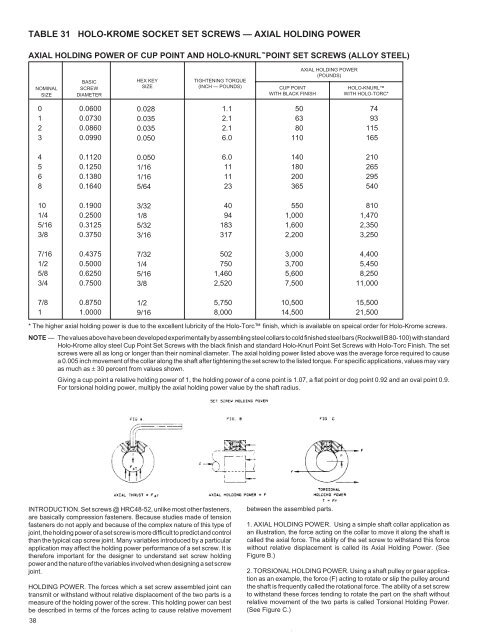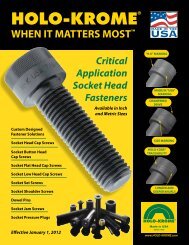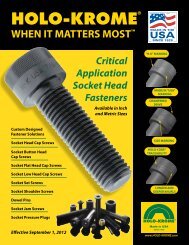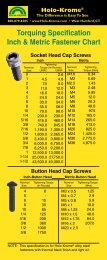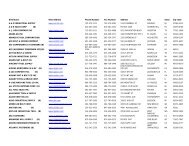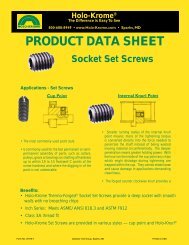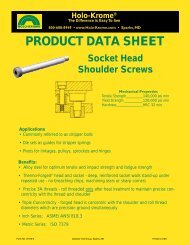Consolidated Tech Man - Holo-Krome
Consolidated Tech Man - Holo-Krome
Consolidated Tech Man - Holo-Krome
Create successful ePaper yourself
Turn your PDF publications into a flip-book with our unique Google optimized e-Paper software.
TABLE 31 HOLO-KROME SOCKET SET SCREWS — AXIAL HOLDING POWER<br />
AXIAL HOLDING POWER OF CUP POINT AND HOLO-KNURL POINT SET SCREWS (ALLOY STEEL)<br />
INTRODUCTION. Set screws @ HRC48-52, unlike most other fasteners,<br />
are basically compression fasteners. Because studies made of tension<br />
fasteners do not apply and because of the complex nature of this type of<br />
joint, the holding power of a set screw is more difficult to predict and control<br />
than the typical cap screw joint. <strong>Man</strong>y variables introduced by a particular<br />
application may affect the holding power performance of a set screw. It is<br />
therefore important for the designer to understand set screw holding<br />
power and the nature of the variables involved when designing a set screw<br />
joint.<br />
HOLDING POWER. The forces which a set screw assembled joint can<br />
transmit or withstand without relative displacement of the two parts is a<br />
measure of the holding power of the screw. This holding power can best<br />
be described in terms of the forces acting to cause relative movement<br />
38<br />
NOMINAL<br />
SIZE<br />
0<br />
1<br />
2<br />
3<br />
4<br />
5<br />
6<br />
8<br />
10<br />
1/4<br />
5/16<br />
3/8<br />
7/16<br />
1/2<br />
5/8<br />
3/4<br />
7/8<br />
1<br />
BASIC<br />
SCREW<br />
DIAMETER<br />
0.0600<br />
0.0730<br />
0.0860<br />
0.0990<br />
0.1120<br />
0.1250<br />
0.1380<br />
0.1640<br />
0.1900<br />
0.2500<br />
0.3125<br />
0.3750<br />
0.4375<br />
0.5000<br />
0.6250<br />
0.7500<br />
0.8750<br />
1.0000<br />
HEX KEY<br />
SIZE<br />
0.028<br />
0.035<br />
0.035<br />
0.050<br />
0.050<br />
1/16<br />
1/16<br />
5/64<br />
3/32<br />
1/8<br />
5/32<br />
3/16<br />
7/32<br />
1/4<br />
5/16<br />
3/8<br />
1/2<br />
9/16<br />
TIGHTENING TORQUE<br />
(INCH — POUNDS) CUP POINT<br />
WITH BLACK FINISH<br />
1.1<br />
2.1<br />
2.1<br />
6.0<br />
6.0<br />
11<br />
11<br />
23<br />
40<br />
94<br />
183<br />
317<br />
502<br />
750<br />
1,460<br />
2,520<br />
5,750<br />
8,000<br />
AXIAL HOLDING POWER<br />
(POUNDS)<br />
* The higher axial holding power is due to the excellent lubricity of the <strong>Holo</strong>-Torc finish, which is available on speical order for <strong>Holo</strong>-<strong>Krome</strong> screws.<br />
NOTE — The values above have been developed experimentally by assembling steel collars to cold finished steel bars (Rockwell B 80-100) with standard<br />
<strong>Holo</strong>-<strong>Krome</strong> alloy steel Cup Point Set Screws with the black finish and standard <strong>Holo</strong>-Knurl Point Set Screws with <strong>Holo</strong>-Torc Finish. The set<br />
screws were all as long or longer than their nominal diameter. The axial holding power listed above was the average force required to cause<br />
a 0.005 inch movement of the collar along the shaft after tightening the set screw to the listed torque. For specific applications, values may vary<br />
as much as ± 30 percent from values shown.<br />
Giving a cup point a relative holding power of 1, the holding power of a cone point is 1.07, a flat point or dog point 0.92 and an oval point 0.9.<br />
For torsional holding power, multiply the axial holding power value by the shaft radius.<br />
50<br />
63<br />
80<br />
110<br />
140<br />
180<br />
200<br />
365<br />
550<br />
1,000<br />
1,600<br />
2,200<br />
3,000<br />
3,700<br />
5,600<br />
7,500<br />
10,500<br />
14,500<br />
between the assembled parts.<br />
HOLO-KNURL<br />
WITH HOLO-TORC*<br />
74<br />
93<br />
115<br />
165<br />
210<br />
265<br />
295<br />
540<br />
810<br />
1,470<br />
2,350<br />
3,250<br />
4,400<br />
5,450<br />
8,250<br />
11,000<br />
15,500<br />
21,500<br />
1. AXIAL HOLDING POWER. Using a simple shaft collar application as<br />
an illustration, the force acting on the collar to move it along the shaft is<br />
called the axial force. The ability of the set screw to withstand this force<br />
without relative displacement is called its Axial Holding Power. (See<br />
Figure B.)<br />
2. TORSIONAL HOLDING POWER. Using a shaft pulley or gear application<br />
as an example, the force (F) acting to rotate or slip the pulley around<br />
the shaft is frequently called the rotational force. The ability of a set screw<br />
to withstand these forces tending to rotate the part on the shaft without<br />
relative movement of the two parts is called Torsional Holding Power.<br />
(See Figure C.)


